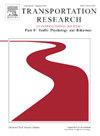电动滑板车安全:态度因素如何影响共享电动滑板车使用者的危险行为
IF 4.4
2区 工程技术
Q1 PSYCHOLOGY, APPLIED
Transportation Research Part F-Traffic Psychology and Behaviour
Pub Date : 2025-07-03
DOI:10.1016/j.trf.2025.06.015
引用次数: 0
摘要
近年来,短途出行的电动滑板车使用量迅速增长。电动滑板车使用的激增,再加上电动滑板车使用者面临的事故风险很高,引发了人们对电动滑板车安全性的担忧。尽管有一些研究关注电动滑板车的安全性,但对于态度因素是如何导致电动滑板车骑行者从事危险骑行行为的,我们知之甚少。本文建立了一个基于调查的实证模型,以确定影响电动滑板车用户参与危险行为的态度因素。我们使用了2022年从芝加哥420名共享电动滑板车用户中收集的调查数据。调查显示,47.7%的受访者在骑电动滑板车时至少经历过一次碰撞或跌落。本研究采用偏最小二乘结构方程模型(PLS-SEM)检验潜在态度因素与风险行为参与之间的关系。此外,我们进行了置换多组分析(PMGA)来评估估计模型中社会人口因素的调节作用。结果表明,骑手的不安全骑行态度和骑行信心是影响其危险行为参与的最重要因素。此外,事故经验、基础设施适宜性、感知享受、交通风险感知和操作风险感知是其他重要的预测因素。在社会人口因素中,性别、年龄、受教育程度和汽车使用频率显著影响骑手的危险行为参与。研究结果强调了基础设施适宜性和事故体验在分析电动滑板车用户骑行行为中的重要性。开发的模型促进了我们对电动滑板车车手危险行为参与的影响因素的理解。研究结果为政策制定者和电动滑板车供应商提供了有价值的见解,旨在降低电动滑板车用户的事故风险。具体而言,我们提出了三个安全对策:(1)安全培训计划,鼓励更安全的态度;(2)基于实践的举措,增强骑行信心;(3)改善基础设施,特别是扩大自行车道。本文章由计算机程序翻译,如有差异,请以英文原文为准。
E-scooter safety: How attitudinal factors influence risky behavior among shared e-scooter riders
In recent years, e-scooter usage for short-distance trips has grown rapidly. This surge in e-scooter use, combined with the high exposure of e-scooter riders to accident risk, has sparked concerns regarding e-scooter safety. Despite some studies focusing on e-scooter safety, little is known about how attitudinal factors lead e-scooter riders to engage in risky riding behaviors. In this paper, we developed a survey-based empirical model to identify the attitudinal factors influencing engagement in risky behaviors among e-scooter users. We used survey data collected from 420 shared e-scooter users in Chicago in 2022. The survey showed that 47.7% of respondents had experienced at least one collision or fall-off while riding e-scooters. We employed the Partial Least Squares Structural Equation Model (PLS-SEM) to examine the relationships between latent attitudinal factors and risky behavior engagement. Moreover, we conducted Permutation Multi-group Analysis (PMGA) to assess the moderating effect of socio-demographic factors within the estimated model. The findings suggest that riders’ unsafe riding attitude and riding confidence are the most influential factors shaping their risky behavior engagement. In addition, accident experience, infrastructure suitability, perceived enjoyment, traffic risk perception, and operational risk perception are among the other significant predictors. Among socio-demographic factors, gender, age, education, and car use frequency significantly influence riders’ engagement in risky behaviors. The results highlight the importance of infrastructure suitability and accident experience in analyzing e-scooter users’ riding behavior. The developed model advances our understanding of factors contributing to e-scooter riders’ risky behavior engagement. The findings offer valuable insights for policymakers and e-scooter vendors aiming to mitigate e-scooter users’ accident risk. Specifically, we recommend three safety countermeasures: (1) safety training programs to encourage a safer attitude, (2) practice-based initiatives to enhance riding confidence, and (3) infrastructure improvements, especially the expansion of bike lanes.
求助全文
通过发布文献求助,成功后即可免费获取论文全文。
去求助
来源期刊
CiteScore
7.60
自引率
14.60%
发文量
239
审稿时长
71 days
期刊介绍:
Transportation Research Part F: Traffic Psychology and Behaviour focuses on the behavioural and psychological aspects of traffic and transport. The aim of the journal is to enhance theory development, improve the quality of empirical studies and to stimulate the application of research findings in practice. TRF provides a focus and a means of communication for the considerable amount of research activities that are now being carried out in this field. The journal provides a forum for transportation researchers, psychologists, ergonomists, engineers and policy-makers with an interest in traffic and transport psychology.

 求助内容:
求助内容: 应助结果提醒方式:
应助结果提醒方式:


